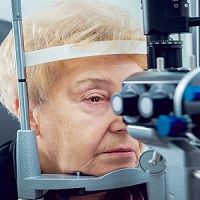Article
Alzheimer's Disease Proteins Could Be the Leading Cause of Age-related Macular Degeneration
Author(s):
Scientists found that amyloid beta proteins accumulate in the retinas of AMD patients – the same types of proteins that settle in the brains of people with Alzheimer’s disease.

New research may have discovered the culprit behind age-related macular degeneration (AMD), one of the leading causes of irreversible loss of central vision in the elderly. Scientists found that amyloid beta proteins accumulate in the retinas of AMD patients — the same types of proteins that settle in the brains of people with Alzheimer’s disease.
There are two forms of AMD: wet and dry. In patients with wet AMD, the retina-damaging growth of leaky blood vessels can be blocked via treatment with anti-vascular endothelial growth factor medications. Since this doesn’t work in everyone, it’s merely a management method, not a cure. There are currently no FDA-approved treatments for dry AMD.
In order to investigate how quickly amyloid beta proteins enter the retina and damage it, Arjuna Ratnayaka, PhD, Vision Sciences at the University of Southampton, conducted a study using R28 cell cultures and mouse models.
Results indicated that the amyloid beta proteins actually entered the retina within 24 hours of exposure and immediately began breaking the cell’s “scaffold structure.”
Ratnayaka explained in a news release, “The speed with which these proteins entered the retinal cells was unexpected. These findings have given some insights into how a normal, healthy retina can switch to a diseased AMD retina.”
The research team explained in their study that the causes of AMD are considered to be complex, with both genetic and environmental risk factors, but evidently share similarities with Alzheimer’s disease.
Ratnayaka concluded, “We know that AMD is caused by a combination of genetic, environmental, and lifestyle risk factors, but this novel discovery could open up new possibilities to understand how the aging retina becomes damaged. Such advances are important if we are to develop better AMD treatments in the future.”
The research and development of further treatments is necessary, because the current method of using vascular endothelial growth factor inhibitors to treat the less common neovascular form is less than ideal, since prolonged treatment was found to actually damage the remaining retinal pigment epithelium. The study showed, this could cause the geographic atrophy of AMD.
The team plans to continue its research, particularly assessing how the amyloid beta proteins penetrate retinal cells — beginning the framework for preventative options or treatment methods.
Related Coverage:
Genetic Mutation Responsible for Form of Macular Degeneration
Subretinal Gene Therapy Improves Vision in Patients with Wet Age-Related Macular Degeneration
Researchers Close In on Genetics of Age-Related Macular Degeneration
2 Commerce Drive
Cranbury, NJ 08512
All rights reserved.





